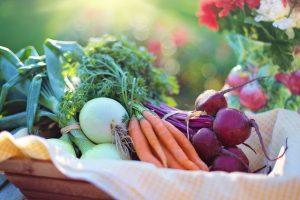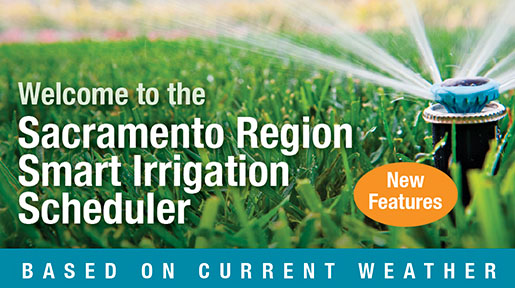By Debbie Arrington
Guest Writer
 When it comes to growing food with less water, the UC Cooperative Master Gardeners of Sacramento County have years of experience.
When it comes to growing food with less water, the UC Cooperative Master Gardeners of Sacramento County have years of experience.
“We’ve been experimenting since at least 2008, when we had the big drought that really got us thinking about water efficiency,” says master gardener Gail Pothour, who heads the team that cares for the vegetable demonstration gardens at the master gardeners’ Fair Oaks Horticulture Center in Fair Oaks Park. “We’ve been looking for more ways to save water ever since.”
That water-wise approach now helps the master gardeners determine what they grow each season as well as how they grow it.
“We never grow corn, for example,” says Pothour. “Sweet corn is one of the worst water hogs. The crops we do grow – tomatoes, peppers, eggplants, squash, beans, etc. – we grow as efficiently as possible. Everything is on drip irrigation. We use lots of mulch.”
As they do with all aspects of gardening, the master gardeners use that hands-on experience so they can better advise the public on how to garden sustainably.
“Most vegetables are not drought tolerant,” Pothour explains. “But there are some varieties that use less water. We seek out varieties of beans, squash and tomatoes from the arid Southwest, native to Arizona, New Mexico, Texas, even Southern California. These vegetables were bred to survive in times of drought; they grow in the desert.”
More Americans are food gardening than ever before, according to the National Garden Association’s annual survey. At least one in every four households actively maintains a vegetable garden; 86 percent grow tomatoes, by far America’ s favorite homegrown crop.
And yes, you can grow tomatoes with less water. “Determinate varieties – bush tomatoes – tend to use less water,” says Pothour, “because they’re shorter plants with a shorter harvest season. And cherry tomatoes can handle almost anything including cut backs in irrigation.”
Determinate varieties include Ace, Roma and San Marzano. They have a bushy habit instead of growing endless vines. Compact “patio” or container tomatoes also tend to use less water for the same reasons.
“Plant tomatoes deep, so even if the soil surface is dry, their roots will stay moist,” Pothour adds.
How much water does a tomato actually need? Typically, a mature tomato plant requires about 5 gallons of water per week, about the same as 1 square foot of lawn.
Tomatoes can not only get by with deep and infrequent irrigation, but thrive, says Pothour. “The Santa Clara Master Gardeners did a three-year trial of tomato irrigation. One group was watered normally, two or three times a week. The second was watered every seven to 14 days. The third, irrigation was cut off entirely at a certain point (once the plant was established). The second and third groups actually tasted better than the tomatoes that were watered normally. Less water intensified their flavor.”
In the master gardeners’ low-water trials, bush beans used less water than pole beans. “Bush beans don’t need all that extra water to grow vine,” Pothour explains. Several Southwest native beans also did well with low-water or dry gardening including cowpeas, tepary beans and bolita beans.
Most popular herbs are naturally low water, she adds. “Rosemary, lavender, thyme, oregano; they’re Mediterranean perennials. They were made for our climate.”
Tips for saving water in the vegetable garden
Any vegetable can be grown with less water by following some simple water-wise tips, says UCCE Sacramento County master gardener Gail Pothour.
- Switch to drip. “Drip irrigation is highly recommended,” Pothour says. “It puts water where it’s needed – at the roots. Hand watering is OK for new seedlings.”
- Cycle, soak and repeat. When using drip or above-ground irrigation, run a cycle, let it soak in, then run again. “That way, you have a lot less runoff and don’t waste water,” Pothour says.
- Mulch, mulch, mulch! A 3-inch blanket of organic mulch (straw, leaves, wood chips) holds in soil moisture, cuts down on evaporation and keeps plant roots comfortable.
- Before planting, build your soil with organic amendments such as compost. The organic material acts like a sponge and retains moisture. The soil is less likely to dry out, even with reduced irrigation.
- Prioritize what you water. “Fruit trees and blueberries are probably the most valuable edible plants you have,” Pothour says. “They’re expensive to replace and take a long time to grow. Make sure they get deep-watered.”
- Cut back on fertilizer. “Adding fertilizer stimulates growth that will need more water,” she explains. “Use low-nitrogen fertilizers.”
- Always check soil before watering. Does it really need it? Use a moisture meter or long screwdriver to test. “Most gardeners over-water,” Pothour says. “Even in our demonstration gardens, we discovered we could cut our water use significantly just by checking the soil and paying attention.”
Debbie Arrington is a longtime home and garden reporter and co-author of the blog Sacramento Digs Gardening: https://sacdigsgardening.blogspot.com/

